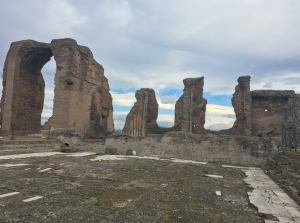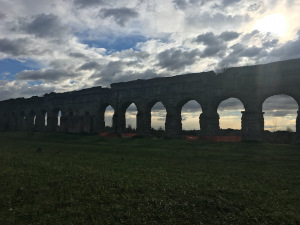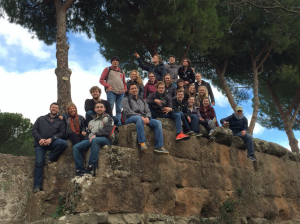Buon Giorno!
First of all, I want to start out by letting everyone at home know that while there were a few earthquakes today, we are all fine! In fact, we didn’t know it happened until about 6 hours after! The epicenter of the three 5.7 magnitude quakes is nearly 62 miles northeast of Rome. However, the metro(subway), schools and other institutions were evacuated here in Rome just to be safe. If you read some of the news articles, you’ll find that this particular area has been hit more than a few times in the last year alone. Definitely not something we’re used to back in Minnesota!
That being said, we had a fantastic day! First, we set off via coach to Villa Quintili. A giant estate, once belonging to two affluent brothers, is now a skeleton of what used to be. The villa contains pretty much everything you’d imagine two young and wealthy senators would want: large baths, private and public residence, water storage, maritime theater, and a gorgeous view of Rome, the mountains and even a volcano. Of course, there was plenty of engineering present- we looked at the massive arcades that were still standing around some of the baths and the residence halls, and heating in the bricks that made up the walls and floors. The remnants of the marble floors and walls, as well as the mosaics were nothing shy of beautiful.
After a little lunch break at Eataly, we got to play in the park! You’re probably wondering why a bunch of engineering students would go abroad to just play in a park… but trust me, there was plenty of learning to be had! We arrived at the Aqueduct park, where two (of the once 11) visible aqueducts rolled through green fields. We got to see Aqua Claudia and Aqua Marcia; Aqua Marcia, which supplies water to capitol hill, is one of the two that is still in use today (along with aqua Virgo-which supplies the Trevi fountain). The aqueducts often took water from rivers or springs in the mountains nearby and carry the water toward the city over various terrains. This is where the engineering really comes in! They used bridge arcades to cross-valleys, and would bury the channels underground when the terrain was raised. It’s all about flow! As long as the aqueducts are slightly downhill, gravity will do all the work, and carry water to fountains, baths, irrigation systems, and even private villas and palaces. We found another use for these miraculous pipes though, as we found ourselves climbing in and around them.
And that wraps up our time here in Rome! Tomorrow we take a high speed train to Naples, and soon after that we’ll be in Florence! Ciao!



No Comments